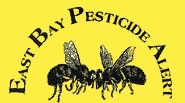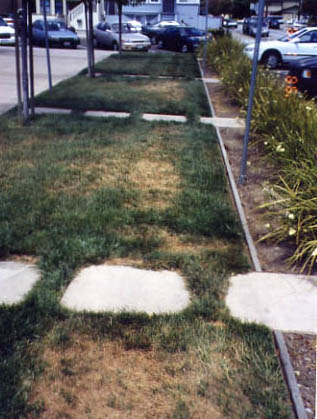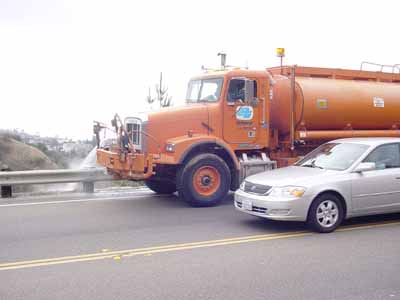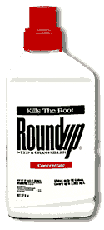
East Bay Pesticide Alert Does Not Compromise Around Health
|
Any organic farmer will point out that healthy soil allows for healthy plants. When a human is exposed to a virus or bacteria but does not get ill, it is because the body's immune system has kicked in and tackled the unwelcome visitor. Plant systems, like human bodies, carry inherent wisdom which is intact unless we interfere with it as we have by using pesticides which kill off natural predators of undesirable guests as well as killing the life forms in soil which support plants' immunological systems. We do not have to accept the use of pesticides (including herbicides, insecticides, fungicides, rodenticides) as a way of life. We have been a living laboratory for chemical companies for the last 60 some years. We can refuse to allow pesticide use in agriculture, in our homes, our hospitals, our schools, our workplaces, our parks, and along streets, roads, and highways. General Pesticide Information What to do if exposed to pesticides Links to pesticide information resources The Bright Side The No "Acceptable Risk" Coaliton Glassy-winged Sharpshooter pages For Specific Information About Alternatives to Toxic Pesticides - see Steve Tvedten's www.getipm.com Free download of Steve Tvedten's book on alternatives to toxic pesticides |
When “IPM” Means
East Bay Pesticide Alert is beginning a mapping project to inform the community, media, and policy makers as to the true extent of public pesticide use in the East Bay. You can help. When you see signs of pesticide use on public property in the East Bay, note the place, time, method, and public agency involved, take a photo, if you can, and contact:
Caltrans District 4 Office (Oakland) East Bay Regional Park District Oakland Department of Public Works UC Berkeley |
East Bay Links
East
Bay Regional Par Oakland
IPM Ordinance - Current and Proposed Exemptions
|
Oakland
Wants to Use Pesticides in the Hills Intersection at Grizzly Peak (photo: Paul Goettlich, mindfully.org) Wildfire Prevention Asssessment District - Oakland IPM Rollback Update: Oakland
City Council Meeting On April 5, the Oakland City Council voted unanimously to direct preparation of environmental impact reviw documents as part of rolling back Oakland's IPM ordinance to allow direct application of two herbicides (glyphosate - in formulations such as Roundup and Rodeo) and Triclopyr (available in Garlon 4 and Pathfinder) on 19 species of plants (not just eucalyptus and broom, but extending to non-native species of plum, cherry, blackberry, and elm) in Oakland's portion (approximately 1,000 acres) of the East Bay's Wildfire Prevention Assessment District. The City Council did not consider the carcinogenic dangers of "inert" ingredients present in commercial formulations, which would trigger Prop 65 notification requirements. Nor did the City Council consider how the introduction of chemical means will be at the expense of safe, mechanical means (goats, volunteer labor). Instead, the City Council justified the new exemption by referring to the best practices of other large landowners in the East Bay, most notably, the East Bay Regional Park District, which routinely uses herbicides in public areas, and UC Berkeley, which can't seem to retain ecologically active professors because of its close ties to the genetic engineering - chemical pesticide complex. We thank all our supporters who came to the meeting on April 5. The struggle continues. After completion of the environmental impact review documents, the revised IPM policy will need to be presented to the public for comment before the rollback becomes law. We will keep you posted. Resolution as Passed by Council April 5, 2005 Each
person speaking in person at a public hearing in Oakland makes
a big impact. (Parking is free (in the lot directly behind city
hall) while you're attending a meeting. Write on the ticket the
name and time of the meeting. Please come scent-free). Contact: Oakland City Council & Local Media
|
Toxic Profiles of Herbicides used in East Bay Hills
Roundup
- fact sheet from CATs Roundup
- 2004 fact sheet from NCAP* New studies link Roundup to
non-Hodgkin's lymphoma in men, increased risk of miscarriage
in women Imazapyr (Stalker) used by UC Berkeley in the East Bay Hills. Used by San Francisco Estuary Invasive Spartina Project. Clopyralid (Stinger and Reclaim) used by UC Berkeley in the East Bay Hills as part of its pesticide-based wildfire prevention project.
|





